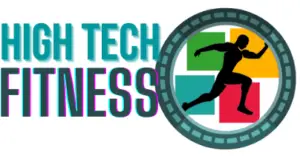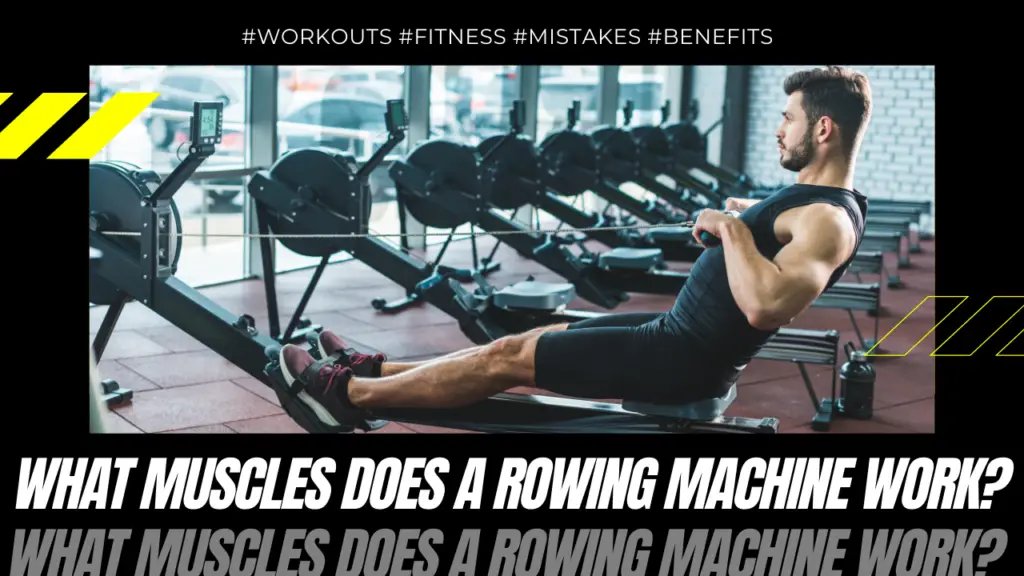
“What can a rowing machine do for my body?” is a question that comes to most people’s minds when they see fellow gym enthusiasts pounding away on one. Yes, the rowing machines are often underrated in the presence of treadmills and ellipticals. But once you start training on them – you are very less likely to be impressed by any other fitness regime.
Why? Let’s find out the benefits of a rowing machine for your body in the guide below!
Page Contents
Rowing Machine – A Full Body Workout
One of the best features of a rowing machine is that it provides a full-body workout. In fact, health experts and fitness freaks alike consider the rowing machine one of the most efficient machines for a complete workout – in the shortest amount of time.
This is because the machine lets you mimic movements similar to those that you would perform in a rowing boat. And from a strength perspective, you will notice the focus emphasized on each part of your body.
The Muscles Used In A Rowing Machine Workout
Generally, you can divide the movement on a rowing machine into four phases: The Catch, The Drive, The Finish, and The Recovery. With each stroke, you will notice different muscles engaging during the workout.
Phase 1: The Catch
If you are rowing a boat, the ‘catch’ is the time when you place the oar in the water – to begin your journey.

The phase is similar when it comes to the rowing machine. With arms bent and the body leaning slightly forward, you are ready to begin the training. The muscles that this phase targets include:
- Triceps
- Deltoids
- Trapezius
- Abdominals
- Lower back
- Hamstrings
- Calves
Phase 2: The Drive
The ‘drive’ refers to the step where you pull the oars out of the water and maneuver the boat forward.
In a rowing machine, you will begin pushing with your legs while continuing to brace and contract your core. With the help of a hip hinge, swing back your body about 45 degrees and then use the arms to pull the handle towards your torso.
Remember, all this should be done in a continuous motion. Also, note the specific order of body movements: legs, core, hips, shoulders, and arms that work the following muscles:
- Deltoids
- Trapezius
- Upper Back
- Glutes
- Hamstrings
- Quadriceps
- Calves
- Biceps
- Forearms
- Middle Back
- Abdominal
- Latissimus Dorsi (the back muscle)
Phase 3: The Finish
The ‘finish’ is the resting phase of the catch step above – but of course, you won’t be resting here for too long.
During this phase, lean the upper body slightly back and extend your legs. You gently engage your arms, shoulders, and back to pull the handle towards your lower chest.
The muscles you can expect to work in the finishing phase include:
- Trapezius
- Deltoids
- Biceps
- Forearms
- Latissimus Dorsi
- Glutes
- Quadriceps
Phase 4: The Recovery
The ‘recovery’ phase is basically a rewind of the above three-phase. During the recovery, extend the arms in front of you, hinge forward from your hips, and bend the knees using the hamstrings to help you pull forward. Keep ‘rowing’ until you are back to the initial ‘catch’ position.

Muscles that are in-focus during the recovery include:
- Trapezius
- Hamstrings
- Calves
- Deltoids
- Triceps
- Forearms
- Abdominals
The Best Rowing Machine Workouts
As you can see, the rowing machine targets nearly all parts of the body, strengthening each area effectively. One of the best things about training on these machines is that you can either do it alone or incorporate it into your routine. The choice is yours!
However, if you are a beginner, we recommend going for 10 minutes of rowing – and gradually increasing the time.
- Start-off with a 5 minutes warm-up where you row at a steady and slow pace.
- Increase your speed and close in at 300 meters.
- Take a 2-minute recovery break where you slow down the machine’s speed to catch your breath.
- Pace up to moderate intensity for 300 meters again.
- Repeat the 2-minute recovery break.
- Pick up speed for this last stretch and complete 300 meters.
- End the session by slowing down the speed and turning off with a stretch.
The above is just a sample workout that is great for beginners. However, you can create your own workouts as per your requirement and stamina.
Common Rowing Machine Mistakes
Proper technique is essential with any exercise equipment. If you are using the rowing machine for the first time, it is a good idea to seek help from a fitness instructor to guide you regarding proper techniques without risking energy.
Here are some common mistakes that rowers make with the machine.
Mistake #1: Rowing With Arms Only
Rowers often misunderstand the rowing machine phases and put too much pressure on the arms when pulling the handle. Unfortunately, this can cause serious harm to your arms, shoulders, and back.

However, experts suggest using 60% of the legs to perform the rowing action while 20% comes from bracing the core and 20% from pulling with the arms. In short, most of the pressure that you use to row the machine should come from the legs.
Mistake #2: Not Following the Proper Order
The proper order for rowing is engaging the legs, core, hips, shoulders, and arms, as we mentioned above. Not following the correct order of movement can enhance the pressure on your back and impact the effectiveness of the workout.
Mistake #3: Hunching the Back
If you have a habit of slumping down on the desk, you will likely sit in the same position when you use a rowing machine. But during a workout, this posture will put a great deal of stress on your back and shoulders.
Instead, try to maintain a stacked posture. Sit tall and focus on engaging your core. Also, relax your shoulders and keep your spine in a natural position.
Mistake #4: Jerking Your Body
Some rowers make the mistake of stroking at an uncontrollably fast pace. However, there is no finish line to chase, so why exert yourself.
To maintain control of the machine, keep an eye on the strokes you perform during the workout. Experts suggest going for a ratio count of 1:2 with the body going in the ‘drive’ faster but relaxing the stroke during the ‘recovery’ mode. Taking calm strokes will keep your body and seat from jerking forward and enable you to enjoy the workout without unnecessary pressure.
Mistake #5: Having To Jerk Your Upper Body
If your legs are pushing quickly, chances are your upper body will have a hard time catching up. Doing the extra work will make your workout less efficient and increase the chances of an injury. Moreover, it is not recommended to stop mid-way during the workout, so maintaining a strong position from the start to the end is necessary.
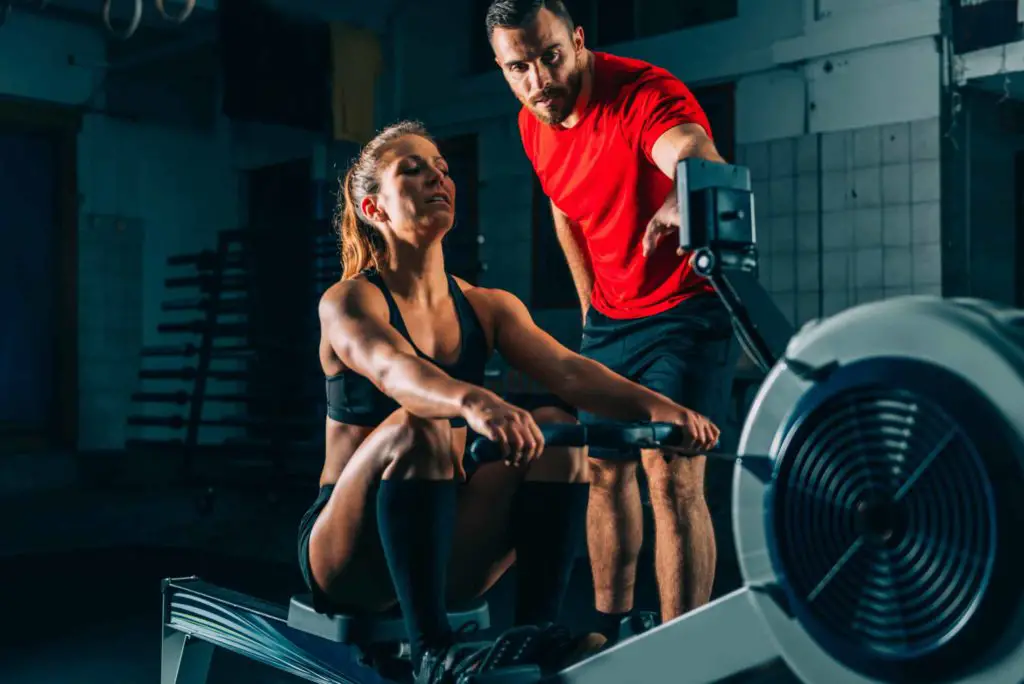
Engage the core to connect the upper and lower body parts smoothly. Keep your entire body in control and your posture intact to avoid any jerky movements.
Mistake #6: Not Checking the Settings
Newbie rowers sit down to row without adjusting the settings on their rowers. However, if the settings are not adjusted according to your body requirements – the machine will feel heavy and exhaust your body early in the workout.
When you sit down at the machine, adjust the damper settings. How exactly you can set up the damper depends on the type of resistance you choose for your rowing machine. For a machine with air resistance for example, the damper settings control the air allowed into the fan blade. Like the gears in a bicycle, the higher the number you set it to, the more air will enter the fan blade.
If you are a beginner rower, we suggest choosing a number between three and five. Gradually you can increase the number according to your stamina.
What Benefits Can I Expect From the Rowing Machine?
Since they work out several major muscle groups, a rowing machine can benefit the body in several ways. Some of the benefits you can avail from regular training include:
Cardio / Aerobic Exercise
Regardless of your age, a fitness plan that includes cardio workout is an important contributor to your overall health. Getting regular cardio exercise helps in weight loss, immune system, and stamina. Additionally, the endorphins released while you work out can improve your mood and sleep quality.
In this regard, the rowing machine is an activity that effectively raises your heart rate and effectively increases our oxygen consumption. It also gives you the ability to easily work up to your target heart rate and slow back down to your resting rate.
Upper-Body Workout
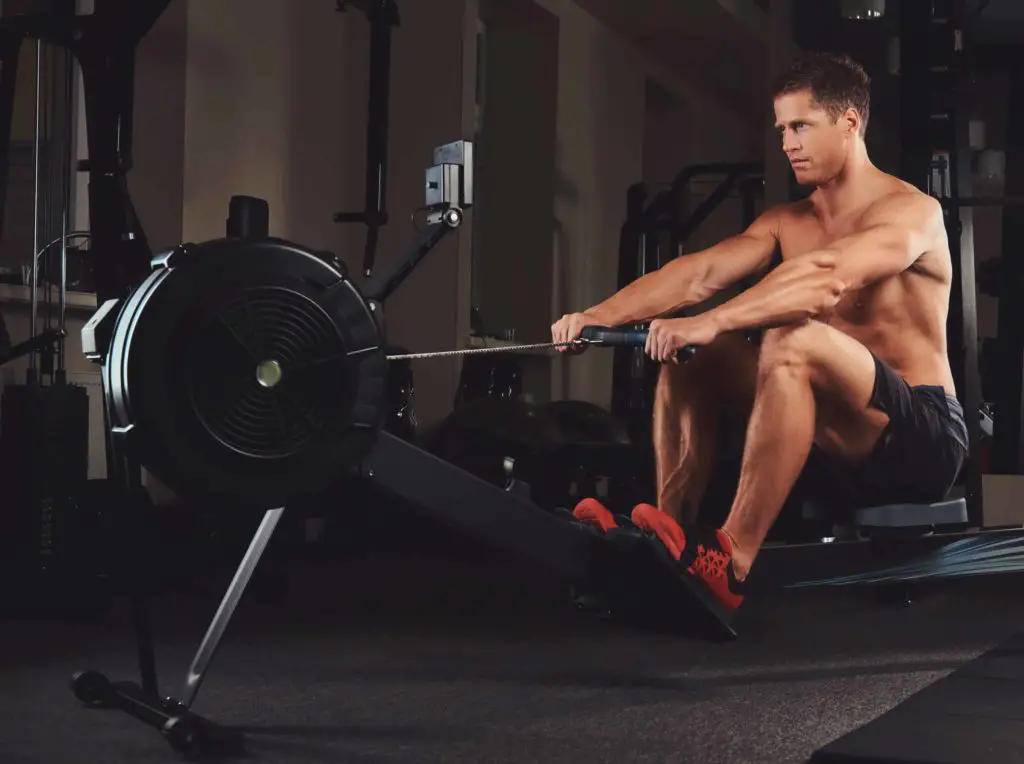
The rowers exercise the rhomboids in the shoulders, trapezii in the upper back, and lats in the lower back when it comes to upper-body workout. This will also improve your posture and reduce any back pain you may experience.
In addition, rowing machines also provide a nice workout for your biceps, which helps to develop a stronger core. Since you need to maintain a strong grip on the oars, you will also develop strong hands and wrists.
Lower-Body Workout
Most rowing enthusiasts consider the rowing machine essentially for a lower-body workout. This is because the main legs muscles involved in the rowing movement emphasize building strong legs and glutes.
At the same time, resistance training on a rowing machine is a great way to maintain flexibility and balance.
Low-Impact Cardio
High-impact workouts such as running, jumping, and aerobics are never recommended for those who are overweight or have existing joint problems. This is because they put you at a higher risk of injury. However, a rowing machine is a great alternative for those who are unable to perform weight-bearing exercises.
The motion exhibited in rowing is natural and low-impacting, thus putting minimal stress on the joints. They are also a great way to strengthen and condition the knees after surgery.
Increased Endurance
In the beginning, a rowing machine may leave you exhausted. But the long-term benefits of regular exercises will increase your endurance level and raise energy. With time, you will notice increased stamina and a boost in your metabolism, giving you the energy to participate in more things you enjoy.
Weight Loss
The full-body workout provided by a rowing machine is a huge calorie burner. At an average, you can expect to burn anywhere between 250 – 350 calories per session – depending on your pace and weight. In fact, you can expect to lose more weight by exercising a few minutes each day on a rowing machine than you would on any other machine that doesn’t engage all muscle groups.
Will a Rowing Machine Give Me Six-Pack Abs?
Rowing is a full-body workout, and hopping on the machine for a few minutes per day can give you great abs. This is because:
- Rowing targets your core muscles
- Rowing is an effective fat-burning exercise
When you complete your rowing action, you will engage the core muscles in the mid-section because they help prevent your lower back from collapsing. With regular use, you will continue to develop the core muscles while adding definition to your abs.
Additionally, burning a good amount of calories will ultimately shed off the excess body fat and reveal your abdominal muscles.
Will Rowing Give Me Big Thighs or Make Me Appear Bulky?

No, you will not become bulky with the use of a rowing machine.
As you see, rowing machines help tone the muscles in the glutes, legs, thighs, shoulders, and upper arms. However, if you are a woman, you won’t gain a masculine, bulky appearance from the workout. Instead, you will get an attractive, well-toned body from the regular use of rowing machines.
Additionally, you won’t gain muscle unless you have a proper diet, meaning very high protein intake, carb intake, and low fat. So, if you are worried about becoming bulky – we suggest watching your diet and consuming just enough calories to replace the ones you have burnt to maintain your overall weight.
Will Rowing Help With The Stubborn Belly Fat?
Anything that gets your heart running is sufficient to decrease the fat in your body – even the most stubborn one that accumulates around the midsection. And since rowing is a great way to burn calories, you can expect to get rid of the belly fat with regular workouts.
How Long Does It Take To Notice The Results From A Rowing Machine?
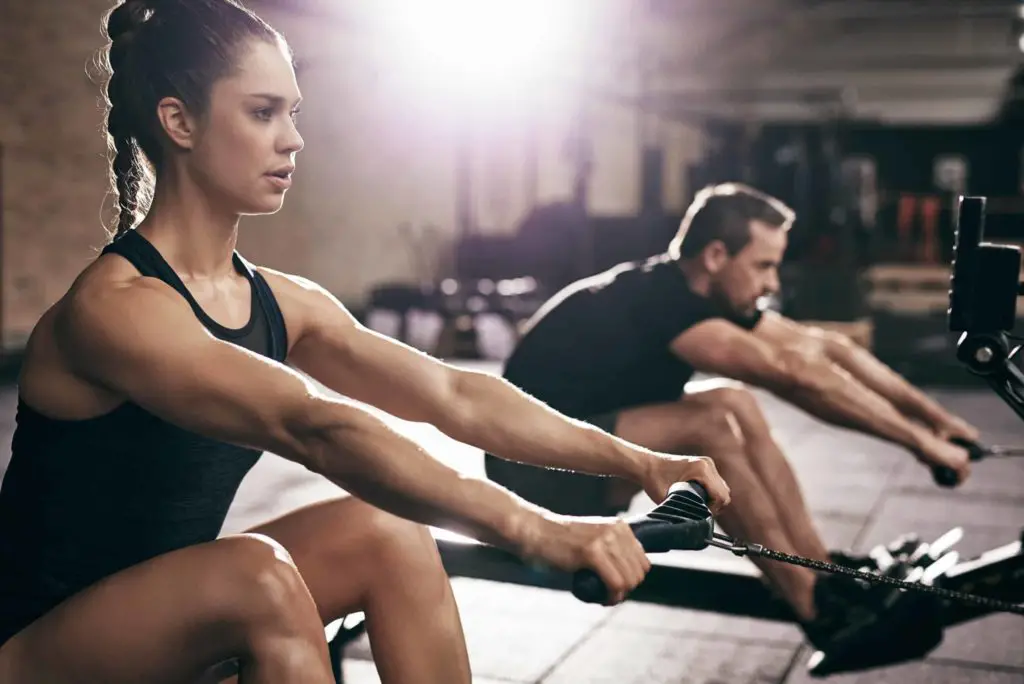
Although the rowing machine’s actual results are hard to decipher, you can expect to see results within a month if you regularly train every day for 30 minutes.
One of the best ways to see effective results with your workouts is to increase the intensity. For example, your goal is to lose weight with a rowing machine. Rowing harder will burn more calories and the weight you lose.
It is also important that you watch your diet while taking part in the workout routine for maximum results. And by watching your diet, we don’t mean to starve yourself, but a diet that comprises of fruits and vegetates, lean protein, and whole grain. A low carb diet will fuel your body without replacing the calories you are working hard to burn off.
Should Beginners Row Everyday?
Aerobic exercises such as rowing are safe for most people. However, if you are a beginner to the fitness regime, start with an exercise session on the rowing machine three times a week. The rest day between the workouts will give your muscles a chance to recover.
You can gradually increase the days to five days per week as you gain endurance.
A ‘talking test’ is the best way to test your speed while rowing. If you are working hard but can still manage to chat with the person on the rower next to you – you are working at a moderate intensity. However, if you cannot have a real conversation, your speed is ‘fast’ and may need modification.
Ideally, a thirty-minute workout session at a moderate speed is sufficient for optimal health. But if you aim to lose weight or sports training, you may need to put in more time and effort.
Can Anyone Do The Rowing Machine?
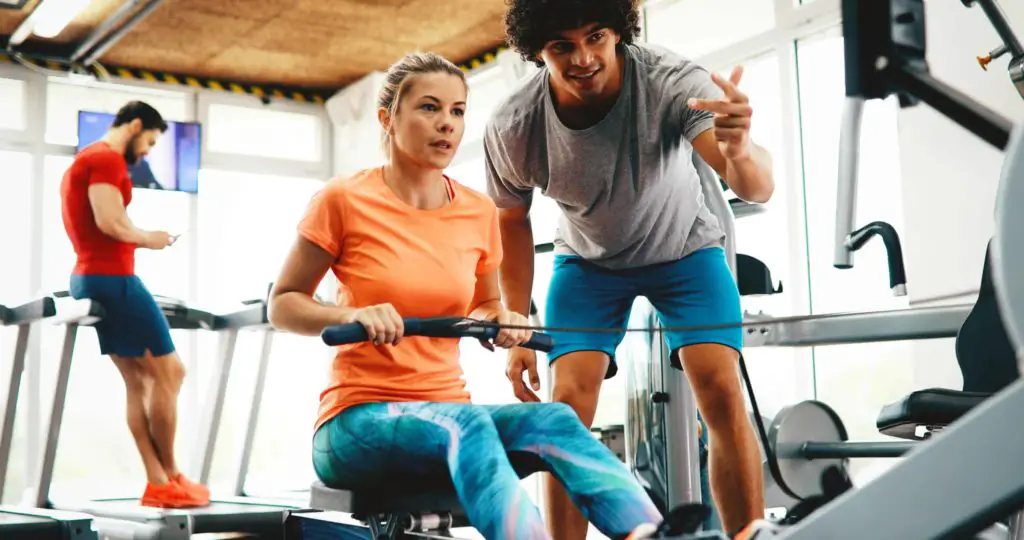
Generally, the rowing machines are deemed safe for everyone – regardless of their fitness level. But with any new workout routine, it is best to consult your trainer to draft out a proper plan according to your unique requirements.
If you have any existing injuries or back pain, we suggest checking in with your doctor to ensure safety from the machine. Using the rowing machine can exacerbate the problem or even cause further injury.
Final Thoughts
So you can see that a rowing machine:
- Provides a full-body workout
- Strengthens each core, helping you tone down the body
- Burns calories, enabling you to lose weight easily
- Is a great way to engage in aerobics and cardio exercises
Above all, it works around 90% of the body’s muscles, giving you the body you need!
Now that you know the benefits, get started with your full-body workout with a rowing machine. And don’t forget to share your experiences and concerns with the workout equipment.
